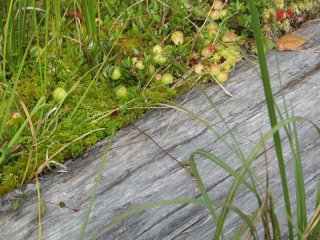Let’s allow cranberries to ripen!
All berry pickers confirm that the abundance of lingonberries is particularly great this year. Such a harvest has not been observed for at least five years, and there are still plenty of lingonberries to be picked.
Lingonberries were in unusually rich and widespread bloom this past spring, which gave hope to see many of them in Latvia’s forests this year. This was also predicted by JSC Latvia’s State Forests’ environmental specialists. Southern Kurzeme environmental planning specialist Solvita Reine, who noticed lingonberries in unusually large volume blooming after inspecting the mating areas of capercaillies, visited these areas also at the end of summer. Yes, there are many, but a long drought in Kurzeme has made some adjustments – the lingonberries are very small in the driest and sunniest areas. Northern Kurzeme environmental planning specialist Aija Ārgale has observed that lingonberries are big and healthy in well-tended and 10-year-old forest stands. Moreover, forests are full of berry pickers, since new roads now take them deep into the woodlands.
Mid-Daugava environmental planning specialist Guna Baltiņa has noticed that lingonberries are particularly ripe in young pine tree stands, where sunbeams can find their way in, but the biggest berries, however, can be found near marshes.
The situation is similar in Vidzeme and Latgale. Western Vidzeme forestry planning head Gunta Krastiņa advises looking for more humid areas, where lingonberries are larger.
Cranberries are also turning red, even though they are still hard and their sides remain pale. Many pickers have already visited swamps, picking up half-ripe cranberries and bringing them home to ripen. However, they cannot imagine that such actions are improper, not knowing that the valuable hippuric acid forms in cranberries only if they are allowed to ripen where they grow.
There will be many cranberries this year, but do no rush to pick half-ripe ones, since they will not be as valuable later!
Cranberries and lingonberries in your green first aid kit
Cranberries are among the most valuable berries in forests. Without boiling and canning, they can be stored for several months. In addition, they also contain substances which suppress fungi and other microorganisms.
The power of cranberries lies not only in phytoncides, benzoic acid and other organic acids, but also in C, B and PP vitamins, microelement potassium, iodine and magnesium. Various vitamins and microelements, contained in cranberries, increase the capability of the organism to remain healthy, improve nerve activity, make skin slightly redder, hair – brighter, nails – stronger, blood-vessels – more flexible.
Due to cranberries’ urine impellent quality, they also reduce blood pressure. Moreover, these diuretic berries do not impel potassium, which is important if a person has oedema caused by heart failure. Cranberries are also good means to combat anaemia. Nevertheless, even such valuables berries as cranberries are not recommended in large quantities for kidney patients and in cases of excessive intestinal acid or intestinal inflammation.
In beauty treatment, cranberries are used in skin whitening and acne treatment.
Lingonberries are valuable sources of sugar, organic acids, biologically active and mineral substances. They contain pectins, tannins, carotene, E and B vitamins. In folk medicine, cranberries have been used as antiseptic, anti-inflammatory, urine impellent and perspiration inducing means since the dawn of time.
Lingonberry tea, made from the berries and their leaves, treats not only cough and bronchitis, but also rheumatism and nervousness.



